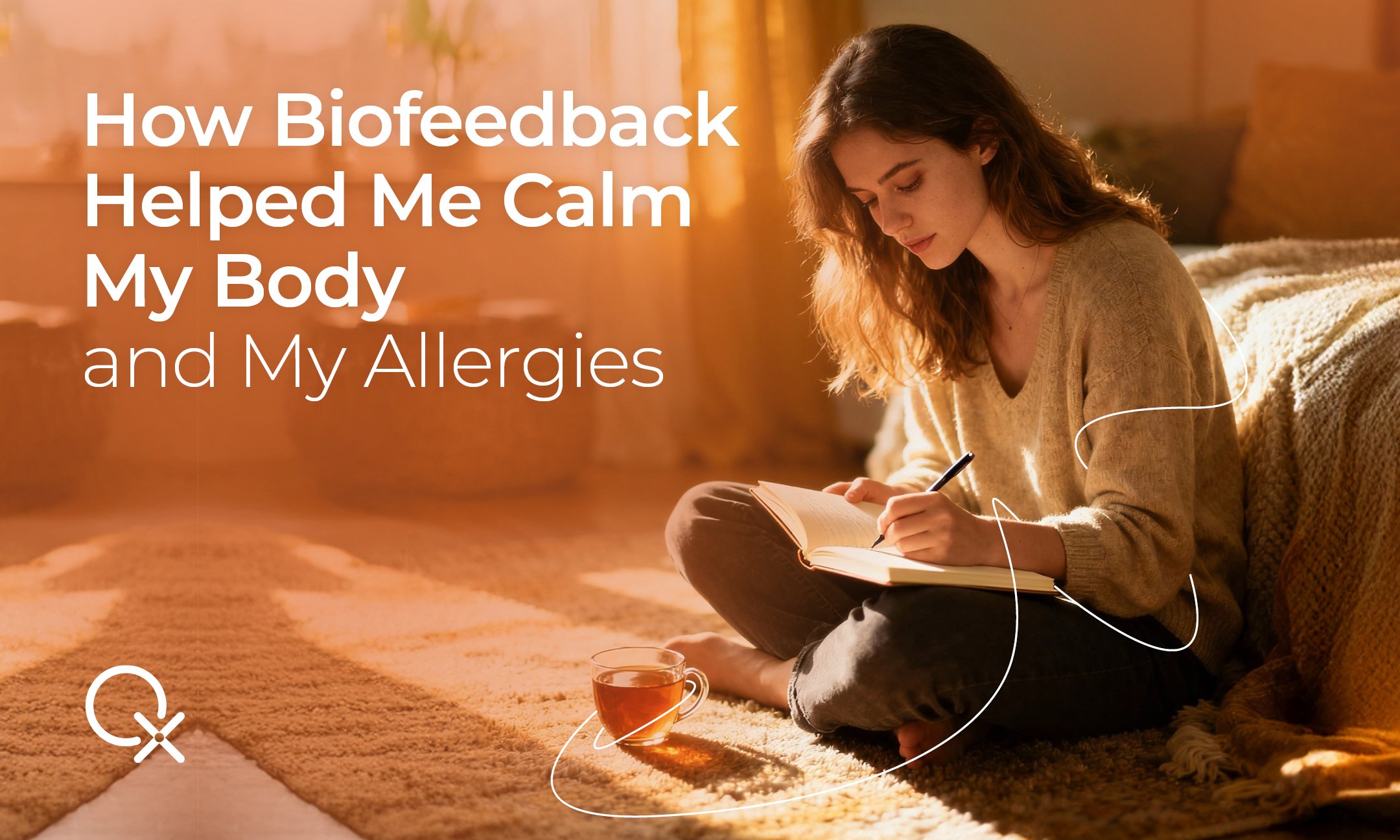
Descubra how stress can worsen alergia síntomas - y how biorretroalimentación supports recovery and balance.
As a child, Carol often sat at the dinner table with a knot in her stomach, worried about letting her parents down. Even small pressures — a test or a teacher’s glance — made her skin itch and her stomach clench.
Years later, during a stressful work project, those old feelings returned. Her mild spring allergies exploded into sneezing, rashes, and exhaustion.
“It felt like my body was reacting not just to pollen, but to the pressure I was under.”
Carol’s experience reflects an emotional allergy. Just as the immune system can misfire against harmless pollen, the emotional system can overreact to safe experiences — affection, responsibility, or expectation.
When this happens, ordinary triggers feel unsafe. The body shifts into stress mode: tense muscles, shallow breath, racing thoughts — and for many, intensified emotional allergy symptoms alongside physical flare-ups.
Common emotional allergy symptoms incluyen:
Why does this happen? Stress activates the fight-or-flight response. Cortisol and adrenaline flood the body, preparing it for danger. If this happens occasionally, the body resets. But when stress is constant — for example rooted in old fears of not performing or being judged — the body never fully calms.
This heightened state:
That’s why allergies often intensify during exams, deadlines, conflicts — and even happy occasions like birthdays. It’s not just pollen or dust, but the tension and anticipation that prime the body to react more strongly.
During that intense work season, Carol realized she was carrying the same fear she had as a child — the fear of not being “good enough.” That hidden anxiety made her stress more explosive, and her body expressed it through allergies.
“It was like my emotions and my allergies had teamed up against me,” she reflects. “The harder I pushed myself, the worse everything got.”
Like Carol many people discover that emotional triggers rooted in childhood — continue to shape their body’s stress responses well into adulthood.
Aquí es donde biorretroalimentación cuántica offers real hope. Instead of pushing through stress or relying only on fixes outside yourself, it gives you a window into how stress patterns shape your body and emotions in real time.
A practitioner begins by listening closely to your history, uncovering how past experiences — childhood stress, unresolved patterns, or hidden triggers — may be fueling your emotional allergy today.
Quantum biofeedback tracks signals you might miss: a racing heart, shallow breath, tense shoulders. These are reflected back to you, making the invisible visible, so unconscious reactions become conscious choices.
Over time, small corrections retrain the body’s stress response. Balance returns faster, with less effort, and with a growing sense of inner authority.
When emotions act like hidden allergens, the nervous system overreacts. Biofeedback interrupts this loop, showing you that your body is not your enemy — and that you have more influence over emotional allergy symptoms than you may have believed.
With regular practice, biofeedback provides a safe and empowering path to:
Instead of being trapped in the cycle of “stress → symptoms → more stress,” biofeedback helps you create a new loop: awareness, calm, and balance.
Simple practices ease stress and allergy cycles, shifting the body from reactivity to balance:
Q: What is an emotional allergy?
A: An emotional allergy is when the nervous system reacts to stress or emotional triggers as if they were allergens. Instead of pollen or dust, it’s anxiety or overstimulation that sparks allergy-like symptoms.
Q: Can emotional allergy symptoms get worse during happy events?
A: Yes. Even joyful occasions can bring hidden stress — anticipation, social pressure, or sensory overload. The body doesn’t always distinguish between “good” and “bad” stress.
Q: Can an emotional allergy make physical allergies worse or even trigger new ones?
A: Yes. When the nervous system is already on high alert, emotional allergy symptoms can heighten the body’s reactivity. This may amplify an existing allergy, or in some cases, contribute to the development of new physical allergy responses.
Q: Can someone develop an emotional allergy later in life?
A: Yes. Emotional allergy symptoms can appear or intensify at any age, often after prolonged stress or major life changes that heighten the body’s sensitivity.
Q: How can I tell if my child may have an emotional allergy?
A: Signs may include sudden physical symptoms (like hives, stomach upset, or headaches) during stressful situations, or strong emotional reactions that seem out of proportion. A practitioner using biofeedback can help uncover these patterns and provide gentle support.
Carol’s story shows that allergies aren’t just about dust or pollen. They can also stem from old stresses and emotional patterns that linger beneath the surface, making daily life feel heavier.
Awareness is powerful. By recognizing an emotional allergy and calming the nervous system with biofeedback, you can break the cycle.
“I can’t stop spring from coming,” Carol smiles, “but now my emotions don’t have to make it worse. I can finally breathe again.”